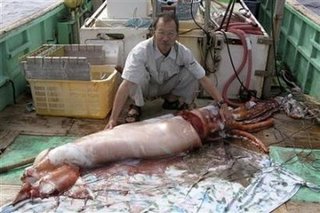The food of the larger toothed whales

Tsunemi Kubodera, chief of Division of Invertebrate Zoology at the National Science Museum of Japan, showing off a Giant Squid near Ogasawara Islands, Japan, on December 4, 2006. The squid is about 3.5 metres (11.5 feet) long and about 50 kg (110 lbs). It was caught at a depth of 650 metres (2132.5 feet) in that area. (National Science Museum of Japan/Handout/Reuters)
These are eaten by the larger odontocetes such as the cachalots as well as by even larger squids, the Colossal Squid.

Update 2007.03.03: Here's a recent news article on a captured Colossal, Mesonychoteuthis hamiltoni:
http://news.bbc.co.uk/1/hi/world/asia-pacific/6385071.stm
Update 2007.03.25: http://www.int-res.com/abstracts/meps/v333/p291-302/
Diving behavior of sperm whales in relation to behavior of a major prey species, the jumbo squid, in the Gulf of California, Mexico
R. W. Davis1,*, N. Jaquet2, D. Gendron3, U. Markaida4, G. Bazzino5, W. Gilly6
*Email: davisr@tamug.edu
ABSTRACT: Sperm whales occur worldwide and feed largely on meso- and bathypelagic squid, but little is known about the behavioral ecology of this predator and its prey. In the Gulf of California, sperm whales are thought to feed on the abundant jumbo (Humboldt) squid, an ecologically and commercially important species. In this study, we attached satellite-linked dive recorders to 5 sperm whales and pop-up archival transmitting tags to 3 jumbo squid in the same area and time period in order to record their diving behavior and movements. Most (91%) deep dives by whales ranged from 100 to 500 m (average 418 ± 216.0 m) and lasted 15 to 35 min (average 27 ± 9.1 min). During daytime hours, jumbo squid spent about 75% of the time in the 200 to 400 m depth range, and sperm whales showed a similar dive-depth preference. The vertical distribution pattern of squid changed during the night, with squid spending about half the time at depths of <200>
KEY WORDS: Physeter macrocephalus · Dosidicus gigas · Diving behavior · Satellite telemeters · Movements · Predator · Prey · Gulf of California


0 Comments:
Post a Comment
<< Home